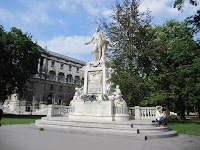Day two started with a drive along precarious narrow, curvy roads hugging the hillside on our way to Bellagio, the last stop of our trip. Lake Como looks like a wishbone with a triangle of land between the two arms of the lake. Bellagio is at the tip of the triangle; standing on the point you see the snow capped Alps to the North.
We met Dave's brother Hugh and wife, Georgia at our hotel and prepared to spend our next three days enjoying the countryside together. On day one we met our guide, Brian, who took us on a wonderful walk through the historical center of Bellagio, up and down the hills of its hamlets, and through the gardens of the elegant Villa Melzi.
We stopped for a lovely interlude at Villa Crella looking at the spectacular views of the lake with church bells ringing nearby. The Villa has recently been restored by a young local family who host wine tastings. It was hard to tear ourselves away from the cheese, brasciola, and bread that accompanied three delicious Italian wines.
Afterwards, the remainder of our walk up and down the hillsides gave us the exercise we needed.
We met Dave's brother Hugh and wife, Georgia at our hotel and prepared to spend our next three days enjoying the countryside together. On day one we met our guide, Brian, who took us on a wonderful walk through the historical center of Bellagio, up and down the hills of its hamlets, and through the gardens of the elegant Villa Melzi.
We stopped for a lovely interlude at Villa Crella looking at the spectacular views of the lake with church bells ringing nearby. The Villa has recently been restored by a young local family who host wine tastings. It was hard to tear ourselves away from the cheese, brasciola, and bread that accompanied three delicious Italian wines.
Afterwards, the remainder of our walk up and down the hillsides gave us the exercise we needed.
We met Brian the next morning for another wonderful day, this time to explore the central lake area by boat. Hugging the coastline, we passed picture manyperfect towns and hamlets, again dotted with exquisite villas. This villa was where Edward and Mrs. Simpson honeymooned. Brian had wonderful stories to tell including the one about the convent on the opposite shore which, in the 1600s, was closed by the cardinal because it had many pregnant nuns.
At the Villa Balbianello, perched over the water, the villa and impeccably groomed gardens are stunning. Originally the residence of the noble family Giovio in the 1700s, it was purchased in 1974 and tastefully restored by Guido Monzini, who furnished it with English and French furniture, numerous collections of art, and the relics and memories of his travels, in particular one to the North Pole and the first Italian ascension to Everest.
This visit was followed by lunch at Isola Comacina on the only island in the lake. Sitting under the trees on a sunny day with the soft wind blowing, we enjoyed a course of marinated local vegetables with warm bread fresh from the oven, followed by a course of fresh lake trout drizzled with local olive oil and lemons, followed by a course of light butter lettuce salad and roast chicken, followed by hunks of Parmesan cheese dug from the wheel, followed by homemade vanilla ice cream with sliced oranges drizzled with banana liqueur, followed by liquor laced coffee. Oh, did I mention the endless bottles of local Soave wine?
We're all resting now. NO dinner tonight!!




















































